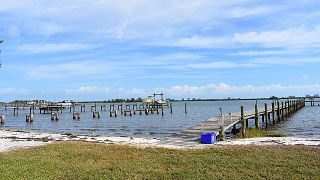Indian River: Difference between revisions
mNo edit summary |
mNo edit summary |
||
| Line 58: | Line 58: | ||
[[Category:Indian River]] | [[Category:Indian River]] | ||
[[Category:Indian River Water Body]] | [[Category:Indian River Water Body]] | ||
Latest revision as of 14:20, December 26, 2021

Indian River (Rio de Ais) is a 121 mile long brackish water lagoon spanning five counties on Florida's East Coast. Indian River is the largest of the three lagoonal basins in the Indian River Lagoon National Estuary watershed.
The Indian River's brackish water is a confluence of four Atlantic Ocean saltwater inlets (Sebastian, Ft. Pierce, St. Lucie and Jupiter), four freshwater rivers (Eau Gallie, Sebastian, Saint Lucie, and Loxahatchee), and numerous feeder creeks.
Location
Indian River lagoon's northern boundary is Brevard County's Scottsmoor at Turnbull Creek. The lagoon merges with the Banana River lagoon at the southern tip of Merritt Island, and then ranges southward to Palm Beach County's Loxahatchee River and Jupiter Inlet.
Coordinates: 28°04'46.1"N, 80°35'16.9"W GIS:28.079483,-80.588031
Water Body
Bridge List
Odor
Indian River's earthen berm causeways tend to impede the flow of algae and rotting seagrass which results in an odor of hydrogen sulfide (ie: rotten eggs) during Florida's hot summer months.
In this video, Dr. Duane DeFreese of the IRC Council explains why the Indian River occasionally smells bad.
Why does the Indian River Smell?
